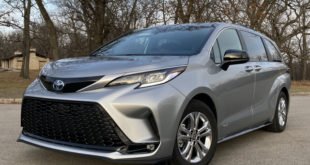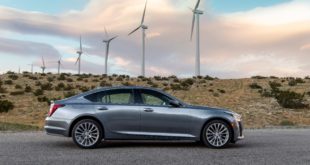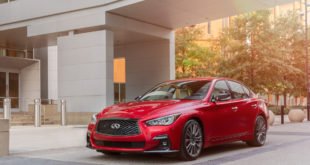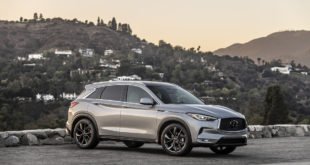
When the test-car fleet crew drops the 2021 GMC Yukon to me on Tuesday, September 15, I’m still optimistic.
“I think you made it just in time,” I joke. Sally is a tropical storm much further down the Gulf Coast at that point, but I’m aware of it. I track it on my phone all day, then at night as my eyes fall and my phone fumbles out of my hand.
In the middle of the night a moan rushes through the balcony glass panels. I snap awake and pull up Twitter. Sally has made a hard right turn, and is pushing toward Pensacola Beach with 105-mph winds, right for us, and right for the Yukon—which has to be back in Atlanta within 48 hours.
I’ll be test-driving the Yukon right in the middle of a hurricane.
___________
At 2:30 in the morning a strong Category 2 hurricane sounds like an ambulance in the distance, one that never gets any closer yet refuses to turn off the siren. The wind hammers on the floor-to-ceiling windows and sounds like a kettle drum during Wagner season at the opera. The lights flicker. Here we go, I gripe to no one but myself. I should have known better.
I have been through hurricanes too many times to get emotional about another one, but in theory I should be smarter about how to deal with this one. In 2004, on the same date, Hurricane Ivan twisted the steel-frame building I spent summers in, threw jet skis in the pool, and brought with it looters. We saw Ivan’s damage from Amsterdam, as we scanned local news flyover footage for our red metal roof. We found it, next to the unmistakable footprint of 35-foot waves that had wiped away any trace of the homes on either side, including their tree-trunk pilings.
Ivan had a sequel just nine months later. Dennis cracked a window when we’d barely patched up the walls and shut down the only road that led into town. We screwed a sheet of plywood over the window and moved on. Nine weeks after that Katrina ripped off the plywood, broke the slate tiles on the roof of our apartment in the French Quarter, broke 19th-century wooden doors, and broke my spirit every unlivable night for the next 18 months.
Sally brings all that up along with an eight-foot tide. Transformers pop to life then die. Patio furniture scoots its ass across the terrace below like it has worms. The rain stings in a million bits of liquid buckshot. My husband and I start to fill bathtubs and pots with water for the inevitable break in the beach water main, find the LED flashlights, charge whatever’s not fully charged, and cook a few things while the wind and rain scythe across Pensacola Beach for the next 12 hours.
Sally drives wood through glass, lifts the tide and pushes it through manmade berms, and makes off with a 15-foot-tall water-park slide, sending it flying off toward the horizon, down the Santa Rosa Sound somewhere toward Destin.
___________
The Yukon is still sitting outside, safe under a pergola late that day, when the winds have settled down near 40 mph, light enough to contemplate a run up I-65.
I had planned to drive to southeast Mississippi on some logging trails and to find a different coffee shop with outdoor seating and high-octane fuel. Now I’m just happy to find a way out.
But how do I get out? A barge took out the Pensacola Bay Bridge. The beach road through the Gulf Islands National Seashore sits under a foot of sand. It’ll be a run-the-gauntlet day across a toll bridge to the mainland, a hustle around one of the Air Force’s playgrounds, then, I hope, an escape route north across the northern edge of the already waning storm.
I square up against the Yukon in the parking lot, mostly to brace myself against the wind. Its grille sits at chest height; if I ran into it in a bar fight, I’d think twice before I threw hands. Fire extinguishers and exit signs and mirrors litter the garage and the parking pad.
Then I look down the Yukon’s side. Something hit the Yukon’s driver side window, the windshield, and the rear-quarter glass. The latter’s broken out. What broke them I don’t know, but I choose to believe that it was a wooden spike, because that places me neatly within the Buffyverse.
I duct-tape a trashbag over the hole to protect it for the 80-mph, 350-mile trip to Atlanta. It’s not so bad, I think. Nothing that can’t be fixed. I drive over to another higher-up parking spot where my Miata sits. Its car cover has flown off, two inches of water sit in the right-side footwell, some red paint has been rubbed off its side mirror, but otherwise it’s OK. I give some thanks, curse a few choice words, and settle in for the arduous trip ahead.
The beach is littered with cars and soffits and chunks of palm trees that were blown to seed, but it’s quiet now. I am the only one on the road as far as I can tell, if you don’t count the cars that were parked on the median strip in hopes of escaping flood waters.
We all fail. The water has formed a bridge from the gulf to the sound through a low-lying neighborhood. It’s too deep to ford, much less to GMC. I stop at a poor Mazda parked on the median hoping to stay dry, and a Tahoe and a RAV4 parked on the bike path, either trying to avoid the flood or to purposely get into it for insurance write-offs.
I’m not going anywhere today, except back home where we still have power and internet, but no running water, no satellite TV, where I have no time to spare the next morning to make it out.
___________
The night after a storm is when you sleep hard, when you’ve dismissed the demons and exorcised the remaining pulses of fear and done all the gnashing over blistered wood floors and drowned backup hard drives. When you wake up, usually, the water has receded.
What’s left behind isn’t ever pretty. Concrete friezes of pillars around our pool have been slapped down. Friends have running water—through their walls and under their tile floors. A balcony panel has fallen from the ninth floor down on a fifth-floor terrace.
The Yukon is dry still, and now I can make it past the beachfront bar that’s still underwater and has lost its amphitheater, past my Exxon station with the automatic tire-fill station; it’s lost all of its canopies too. Street signs tilt at drunken angles like the skydancers in front of car dealerships.
I get to the bridge and explain to the police that I’m headed out of town and coming back. By Saturday I should be fine to get back, they promise. I pick my way across and up into lower Alabama and try to find spots where I know I can get through muck without nailing a tire. I won’t get to tow with the Yukon, unless I want to fish the jet ski from the parking lot where it beached itself. I won’t carry other people, because one stranded person is already one too many.
What can you learn about a full-size SUV on a five-hour drive through torrential rain and still-brisk 50-mph winds? You learn that driving any vehicle this large should be about calm strength, which the Yukon’s 420-horsepower V-8 delivers in a steady stream of torque through its 10-speed automatic. It should be about traction, for which it taps true low-range four-wheel drive, not crossover all-wheel drive. It should be about the sense of safety, which it implies with its bulk and delivers with its tech. The Yukon does it all: it steers precisely for maybe the first time ever, vibrates my seat with haptic warnings of washed-out roads, and never puts a tire wrong under inches of murky water with no clue as to their contents.
You learn that interior designers should put all the controls in the background of your mind, with no Clippy-type functions insisting for your attention. GM’s navigation works OK, but its Apple CarPlay execution is better yet, invisibly integrated and quick and responsive on a big 10.2-inch touchscreen.
Then you learn that phone and car-based navigation are of no use when cell towers are bent and satellite dishes are down. I freelance a route around Brewton, Alabama, where I stop with dozens of cars and trucks and trailers at six feet of water sloshing from a swollen river over the only route north. I shouldn’t even be on the road, because in the hours after a storm, fire and rescue ops need clear streets to get heart attack victims, remove fallen power lines, pull away the carcasses of trees, and plow sand.
You learn to remember good fortune. In the most wicked of ironies, Sally has made landfall 16 years to the day, nearly to the hour, as Ivan, in the same location. Some folks have lost everything, though it’s less broken than after Ivan, where flattened trees greeted us 80 miles from the beach.
You learn to appreciate the finer things, like a cooled leather seat and a Whataburger with extra pickles.
I make it to the interstate in twice the time it usually takes. The five-hour drone goes without incident other than podcast history pissing me off; it’s the never-learning part that gets me angry. The Yukon gets something close to 18 mpg on its trip meter, so I only need to stop once, mostly to breathe.
___________
I pull into Atlanta covered in palm-tree fibers and rub marks that streak up the Yukon’s hood, left behind by sheer velocity. I haven’t shaved or showered. I look like Yukon Cornelius, if his beard had gone gray.
The rain is just ticking up in Atlanta, a half-foot of water maybe by the time it’s done. Pensacola Beach will tally 24.8 inches in two days when Sally’s had her ride. It’s useless to shake a fist at the sky. I’m too tired, anyway. All I want is to fall into bed and into a deep sleep.
Ah, crap. I haven’t even sat in the back. I climb in before I hand off the Yukon to its minders. I can fit in the third row with plenty of headroom and good leg support. My knees touch the back of the second row seats but I can deal with it. I fold them down, because I have to bring home at least 25 gallon jugs of water because our toilets need it until further notice. With a sigh, I turn out of our apartment’s parking lot and head back out to Kroger, filthy but no longer discouraged. I’ll get a warm shower when the day is done, and not everyone does.
I wasn’t alone in driving the Yukon in the middle of a natural disaster. Car writers out west drove GMC Yukons through the smoke of wildfires while I sat with it through the surge of an unexpectedly strong hurricane. Storms used to depower as they approached; now they grow more intense and damaging as they grow near. Something’s deeply out of kilter, and we have to acknowledge it. We are not powerless.
I wonder how many times life will go on, in whatever bent way it comes back, until I decide it’s not worth it.
I return a couple of days later with my tough little Honda to pick up the pieces. The water has drained away, the damage crews have arrived to clean up. Insurance claims have been filed through mobile phones. The cops have started to ticket non-residents who try to sneak onto the beach for the biggest, most amazing sea shells you’ve ever seen, the ones that settle softly on the white-sugar sand after the big storms. A dozen glossy conchs and a constellation of starfish sit on our patio table to dry out. It’s all coming back together again, if slowly.
We’re still looking for that water slide, though. If you see it drifting by, somewhere near Panama City, do us a favor and point it toward home.



